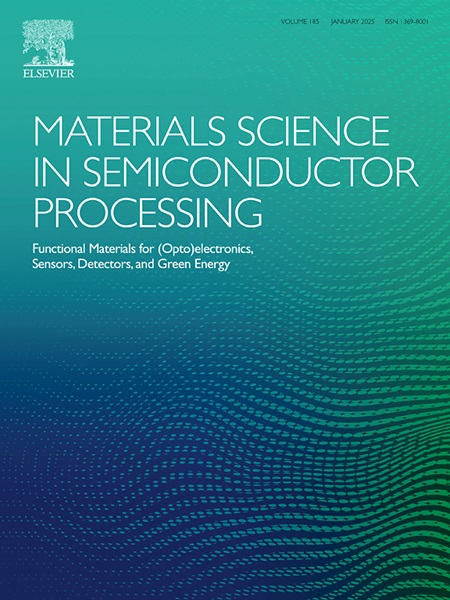Optimizing the ferroelectric and piezoelectric performance of polyvinylidene fluoride (PVDF) /glass films using spin coating
IF 4.2
3区 工程技术
Q2 ENGINEERING, ELECTRICAL & ELECTRONIC
引用次数: 0
Abstract
This research investigates optimizing the ferroelectric and piezoelectric performance of polyvinylidene fluoride (PVDF)/Glass films using spin coating by changing morphological structures. Films were prepared at 3000 and 6000 rpm using a 2wt% PVDF solution in Dimethylformamide (DMF). Attenuated Total Reflectance - Fourier Transform Infrared Spectroscopy (ATR-FTIR) analysis indicated both the samples displayed characteristic absorption band corresponded to β and γ phases. Piezo Force Microscopy (PFM) was employed to study the ferroelectric and piezoelectric morphology. The 6000 rpm film exhibited more defined, self-assembled nanodots, indicating superior piezoelectric and ferroelectric properties. Poling with DC voltages up to ±10 V induced a polar gamma phase, leading to assertive ferroelectric behaviour, especially in the 6000 rpm film. The 6000 rpm film demonstrated 180° phase reversals under different poling voltage directions. The piezoelectric coefficients (d33) vary from 3 to 6.3 p.m./V in 3000 and 6000 rpm films. The 6000 rpm film shows promise for applications in ferroelectric storage devices, non-volatile memories and flexible nano generator applications.
采用自旋镀膜技术优化聚偏氟乙烯(PVDF) /玻璃薄膜的铁电和压电性能
本研究通过改变聚偏氟乙烯(PVDF)/玻璃薄膜的形态结构,研究了自旋镀膜优化PVDF /玻璃薄膜的铁电和压电性能。使用2wt% PVDF溶液在二甲酰胺(DMF)中以3000和6000 rpm的转速制备薄膜。衰减全反射-傅里叶变换红外光谱(ATR-FTIR)分析表明,两种样品都显示出对应于β和γ相的特征吸收带。利用压电显微镜(PFM)研究了材料的铁电和压电形貌。6000转/分的薄膜表现出更清晰、自组装的纳米点,显示出优越的压电和铁电性能。直流电压高达±10 V的极化诱导极性伽马相,导致坚定的铁电行为,特别是在6000转/分的薄膜中。在不同的极性电压方向下,6000 rpm的薄膜表现出180°的相位反转。在3000和6000 rpm的薄膜中,压电系数(d33)在3到6.3 pm /V之间变化。6000转/分钟的薄膜有望应用于铁电存储设备、非易失性存储器和柔性纳米发电机。
本文章由计算机程序翻译,如有差异,请以英文原文为准。
求助全文
约1分钟内获得全文
求助全文
来源期刊

Materials Science in Semiconductor Processing
工程技术-材料科学:综合
CiteScore
8.00
自引率
4.90%
发文量
780
审稿时长
42 days
期刊介绍:
Materials Science in Semiconductor Processing provides a unique forum for the discussion of novel processing, applications and theoretical studies of functional materials and devices for (opto)electronics, sensors, detectors, biotechnology and green energy.
Each issue will aim to provide a snapshot of current insights, new achievements, breakthroughs and future trends in such diverse fields as microelectronics, energy conversion and storage, communications, biotechnology, (photo)catalysis, nano- and thin-film technology, hybrid and composite materials, chemical processing, vapor-phase deposition, device fabrication, and modelling, which are the backbone of advanced semiconductor processing and applications.
Coverage will include: advanced lithography for submicron devices; etching and related topics; ion implantation; damage evolution and related issues; plasma and thermal CVD; rapid thermal processing; advanced metallization and interconnect schemes; thin dielectric layers, oxidation; sol-gel processing; chemical bath and (electro)chemical deposition; compound semiconductor processing; new non-oxide materials and their applications; (macro)molecular and hybrid materials; molecular dynamics, ab-initio methods, Monte Carlo, etc.; new materials and processes for discrete and integrated circuits; magnetic materials and spintronics; heterostructures and quantum devices; engineering of the electrical and optical properties of semiconductors; crystal growth mechanisms; reliability, defect density, intrinsic impurities and defects.
 求助内容:
求助内容: 应助结果提醒方式:
应助结果提醒方式:


